Google Ads Targeting Guide 2022
Complete Tutorial And Best Practices Of Google Ads Audience Targeting

When advertising on Google Ads, you could find numerous types of targeting options and methods to reach your most valuable leads.
In this guide, you’ll find out all how to target people that could be interested in your business within the Google Ads campaign.
A Quick Navigation to Google Ads Targeting Guide:
- 1. Google Ads targeting types
- 2. Audience targeting
- 3. Content targeting
- 4. Similar audience targeting
1. Google Ads targeting types
Within Google Display Network Ads you can choose from the following targeting types:
- Content targeting
- Audience targeting
Let’s break down these categories of targeting:
- Content targeting:
- Keyword targeting
- Placements
- Topics
- Audience targeting:
- Demographic targeting:
- Gender
- Age
- Parental status
- Household income
- Detailed demographics:
- Parental Status
- Marital Status
- Education
- Homeownership Status
- Employment
- Affinity interests – What their interests and habits are
- In-market interests and life events – What they are actively researching or planning
- Remarketing – How they have interacted with your business
- Custom Audiences:
- People with any of these interests or purchase intentions
- People who searched for any of these terms on Google
- People who browse types of websites
- People who use types of apps
- People who visited certain places
- Demographic targeting:
Audiences and content targeting
Define who you want to target within your Google Ads campaign:
- Audiences,
- Demographic,
- or Narrow your reach with:
- Keywords,
- Topics,
- or Placements

Audience targeting
Audiences are groups of people with specific interests, intents, and demographics, as estimated by Google. They’re people you can show your ads to.
1.1. Define your Audiences, Demographics (People: who you want to reach)
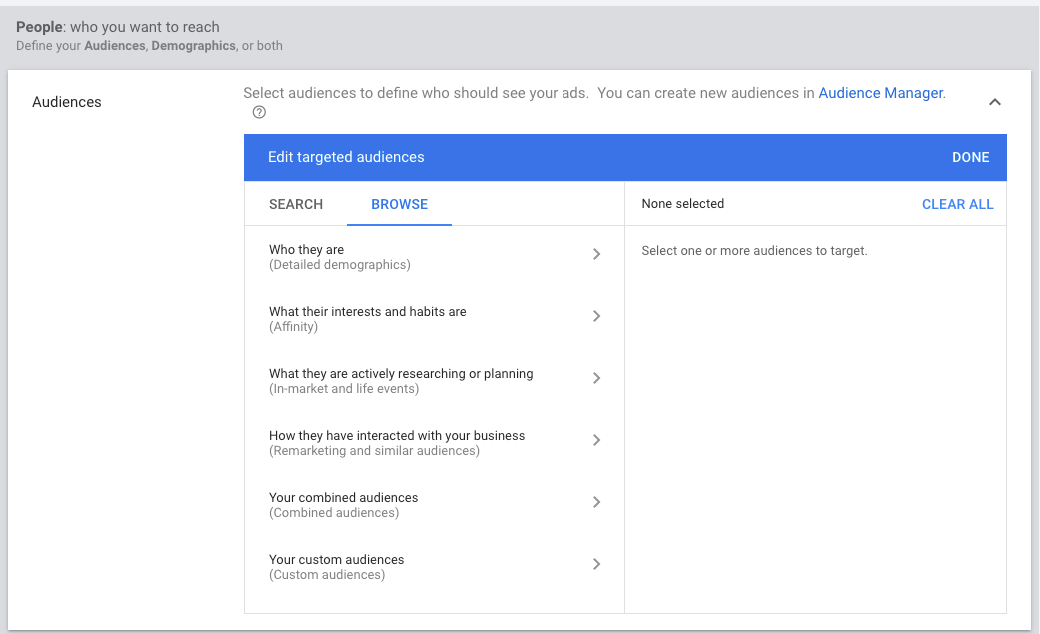
Demographics
1.2. Demographics ➜ Select your demographic targeting

With demographic targeting, you can reach people who are likely to be in the demographic groups that you choose, including:
- gender,
- age,
- parental status,
- household income.
2. Audience targeting
Audiences
Select one of the audience types to define who should see your ads:
NOTE: Adding too many targeting options or restrictions may limit your campaign’s reach.
2.1. Audiences ➜ Select audiences to define who should see your ads. You can create new audiences in Audience Manager
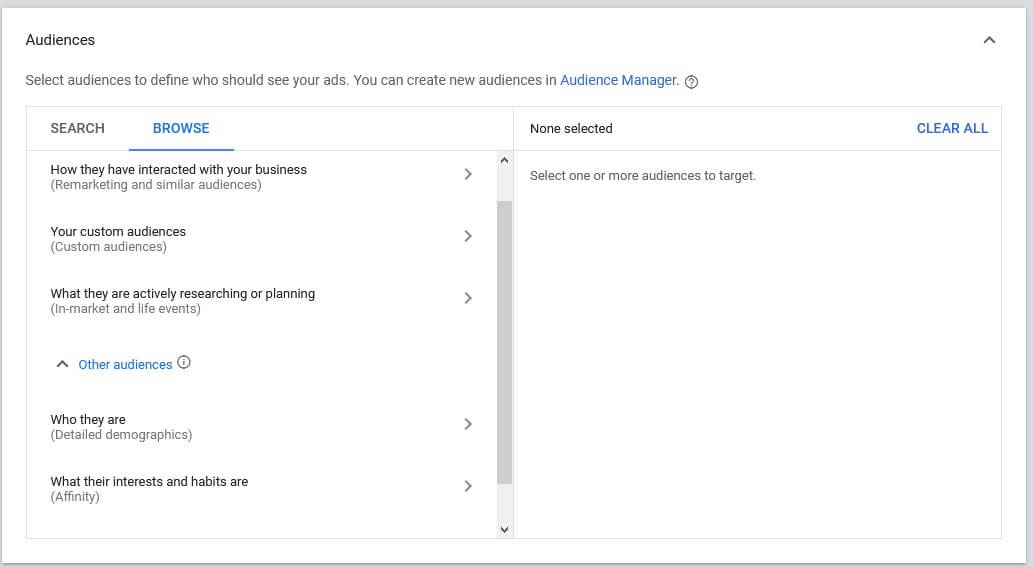
The image below may help you choose the best audience type for your campaign goal.

❗ I would suggest picking one audience type per ad group for accuracy and an easier optimization process. You may also skip the audience targeting and proceed to the next steps if you wish to target just specific placements (i.e. websites/apps/app categories/youtube channels/youtube videos)
Data from your audience sources may be used to improve the bidding and targeting of your audience campaigns.
If you’re looking to target an Audience similar to that which has installed specific apps, check our article about Installed App Category Targeting
3. Content targeting
3.1. Content ➜ Narrow your reach with Keywords, Topics, or Placements

Narrow your reach with:
- Keywords (Keyword targeting lets you choose words or phrases related to your products or services. The keywords you choose help show your ads on relevant websites, apps, and videos);
- Topics (Topics are based on broad industries or interests, such as agriculture or music.);
- or Placements.
Keywords
3.2. Keywords ➜ Choose terms related to your products or services to target relevant content
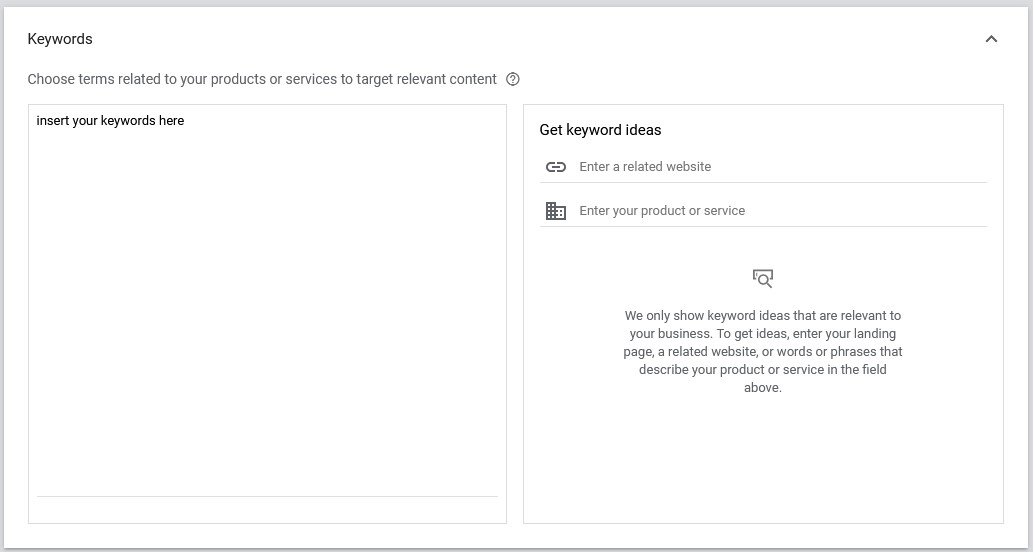
Keyword targeting lets you choose words or phrases related to your products or services to help show your video ads on relevant YouTube videos, YouTube channels, or websites that your audience is interested in.
Pro Tip: For Google Display Network Ads, keep your keyword list small, around 5-20 very related keywords and phrases that are highly relevant to your ad content.
Topics
3.3. Topics ➜ Select topics to show ads on content about specific subjects
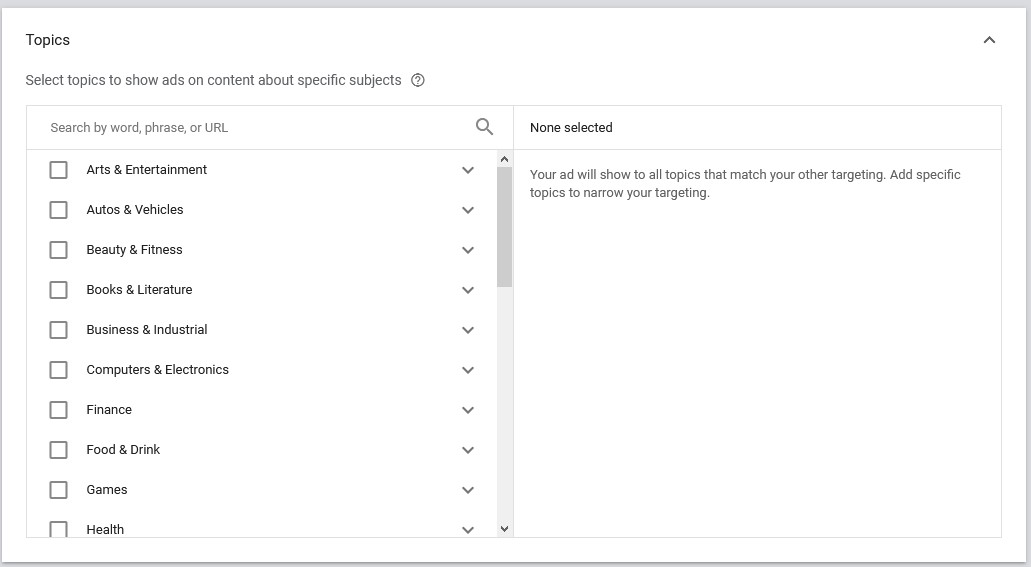
Topic targeting is a simple way to place your ads on many webpages, apps, and videos about a certain subject.
Topics are based on broad industries or interests, such as agriculture or music. For example, by targeting the “Autos & Vehicles” topic, your ad may appear on websites, apps, or YouTube videos with content about cars or other automotive themes.
Placements
3.4. Placements ➜ Select your placement targeting
Placements are locations where your ads can appear on YouTube or the Google Display Network.
A placement can be:
- Website or a specific page on a site,
- Mobile app,
- App categories,
- YouTube channels,
- An individual YouTube video.
With placement targeting, you can add placements to ad groups in your Video Ads campaigns and Google Display Network campaigns.
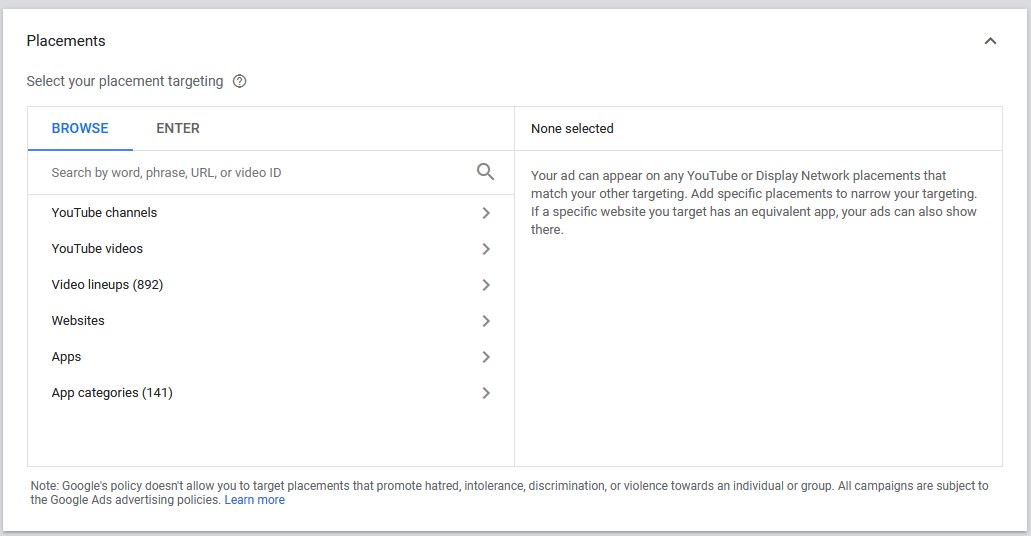
For Video campaigns: When you add Display Network placements, your ad may still run in eligible locations on YouTube. And when you add YouTube placements, your ad may still run in eligible locations on the Display Network.
Target channels, videos, apps, websites, or placements within websites. For example, you can target an entire high-traffic blog or just the homepage of a popular news site. Placements can include:
- YouTube channels
- YouTube videos
- Websites on the Google Display Network
- Apps on the Google Display Network

Note
When you add Google Display Network placements, your ad may still run in all eligible locations on YouTube. And when you add YouTube placements, your ad may still run in all eligible locations across the Google Display Network.
Keep in mind: If you have “Video partners on the Display Network” selected under “Networks” and you add Google Display Network placements only, your ads may still show on YouTube.
4. Similar audience targeting
Similar audience targeting allows you to show ads to people who share characteristics with people on your existing remarketing lists. This article explains how to add this type of targeting to your campaigns.
Similar audience targeting is available for:
- Display Network
- Search Network Ads
- YouTube Ads
- Discovery ads
- App campaigns
- Performance Max Campaigns
Similar audience lists are automatically created and updated in real-time once you have set up at least one eligible list in the Google Ads Audience Center library. It’s recommended that you have a remarketing strategy in place before running Similar audiences.
Benefits of using a similar audience
- More reach: Extend the reach of your campaign towards new users who are similar to your existing users, up to five times more than with remarketing lists alone.
- Improved conversions: See 41% more conversions by combining Similar audiences with Display remarketing.
- Powered by machine learning: Similar audience lists are updated in real-time using machine learning capabilities that analyze millions of signals to optimize performance.
- Easy to manage: Similar audience lists automatically appear in eligible Google Ads accounts. Eligibility is determined when there is enough statistically significant similarity found between new users and the original remarketing list.
- Target efficiently: Original remarketing lists are automatically excluded from Similar audience lists, making sure you target new users only.
Learn how to create and add similar audiences to your targeting.



